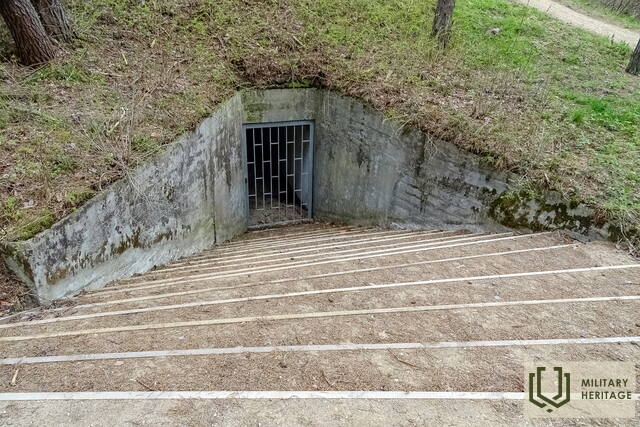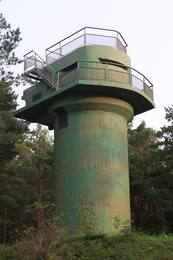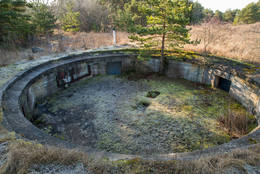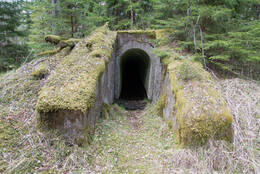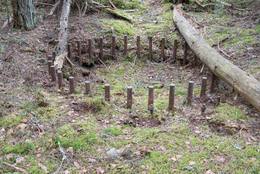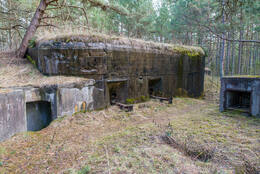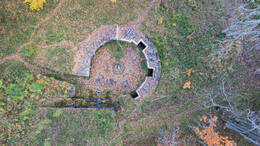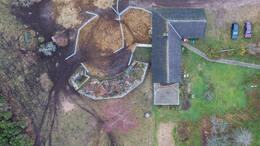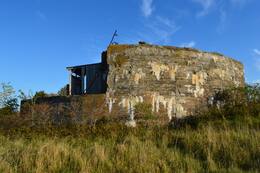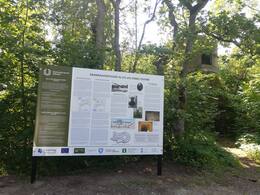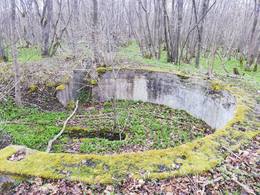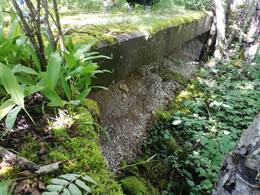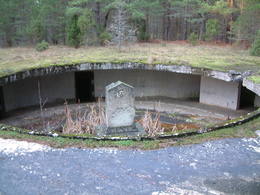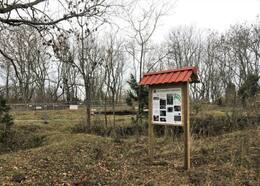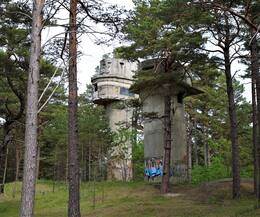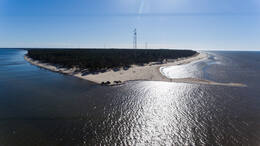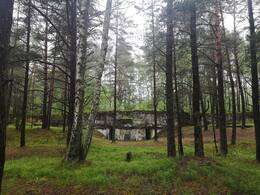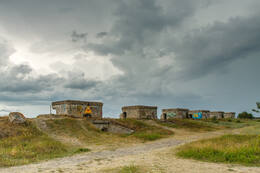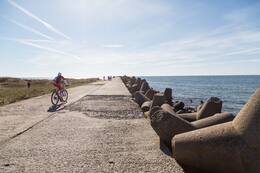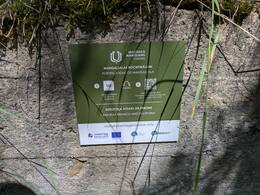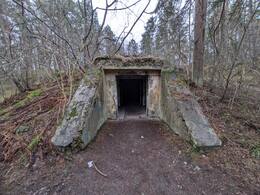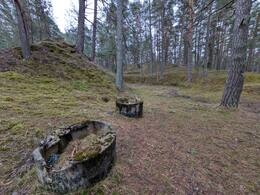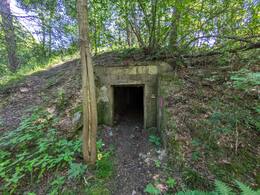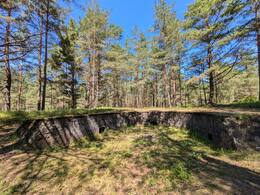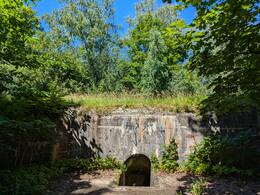Pakrantės gynybos baterija
I WW1, II Antrasis pasaulinis karas, IV Sovietų okupacija
Pakrantės įtvirtinimai, skirti atremti jūrų atakas.
Daugiau informacijos šaltinių
Pakrančių gynybos baterijos (diggers.lv)
Susijusios vietos
Ventspilio 46-osios pakrantės gynybos baterijos ugnies korekcijos bokštas
Atkurtas 46-osios pakrančių apsaugos baterijos ugnies valdymo bokštas Ventspilyje yra Saulrietos gatvėje ir lankytojams prieinamas apžvalgos bokšto pavidalu. Šalia bokšto yra keturios artilerijos pabūklų pozicijos, ir tai vienintelė tokios geros būklės Antrojo pasaulinio karo pakrančių gynybos baterija Latvijoje. Lankytojai gali lipti bokšto laiptais į lauko apžvalgos aikštelę su vaizdu į jūrą. Šalia bokšto yra informacinis stendas su QR kodu. Naudodami QR kodą galite žiūrėti animaciją apie istorinius įvykius. Į bokštą veda nauja gatvė, didelė automobilių stovėjimo aikštelė ir medinis pėsčiųjų tiltas, einantis per šalia bokšto esančią saugomą gamtos teritoriją.
Šis karinis kompleksas buvo pastatytas 1939 m., žymint SSRS karinių bazių statybos Latvijoje pradžią. 46-oji pakrančių apsaugos baterija turėjo keturias pozicijas B-13 tipo pabūklams. Pirmąjį karinį mūšį ši baterija surengė 1941 m. birželio 24 d., kai Ventspilio uostą užpuolė vokiečių torpediniai kateriai, kurie baterijų ugnimi buvo atitraukti nuo Baltijos jūros krantų. Birželio 28 d. sovietų armija susprogdino pabūklus ir pasitraukė.
Olmano baterija Nr. 456 (sovietų karinė bazė „Krasnoflotska“)
Pirmosios pakrantės gynybos baterijos Irbės sąsiaurio gynybai buvo pastatytos po 1912 m., kai buvo patvirtintas Baltijos laivyno minų ir artilerijos gynybos pozicijų planas, kuriame buvo numatytos kelios pakrantės gynybos baterijos ir jūros minų statymas.
Irbės sąsiaurio pozicija buvo toliausiai į pietus, o jos užduotis buvo užblokuoti bet kokį priešo patekimą į Rygos įlanką. Pagrindinis dėmesys buvo skiriamas jūrinėms minoms, kurių dešimtys tūkstančių buvo padėti Irbės sąsiauryje Pirmojo pasaulinio karo metu Baltijos laivyno laivai. Tik 1916 m. Saremos salos pietiniame gale, Sorvės kyšulyje, pradėtos statyti pakrantės gynybos baterijos. Iš viso buvo pastatytos septynios baterijos, o 43-ioji baterija buvo aprūpinta 305 mm pabūklais. Latvijos Irbės sąsiaurio pakrantėje gynybos baterijų nebuvo pastatyta.
Net ir įkūrus Latvijos Respubliką, Latvijos armija ir karinis jūrų laivynas neįrengė artilerijos pozicijų Irbės sąsiauriui ginti.
Padėtis pasikeitė po 1939 m. spalio 5 d. Latvijos Respublikos ir SSRS savitarpio pagalbos pakto, kuris numatė Raudonosios armijos ir Baltijos karinio jūrų laivyno kontingento dislokavimą Kuržemėje. Sovietų Sąjungos planuose taip pat buvo numatyta sukurti pakrantės gynybos sistemą pagal 1912 m. planą su patobulinimais. Buvo numatyta pastatyti pakrantės gynybos baterijas Liepojos tvirtovės vietoje, naujas baterijas į pietus nuo Ventspilio (46-oji baterija) ir dvi baterijas siauriausioje Irbės sąsiaurio dalyje netoli Mikeltornio. Jau po Latvijos okupacijos ir aneksijos Baltijos karinio jūrų laivyno pakrantės gynybos planai buvo papildyti ir iki 1941 m. birželio mėn. buvo planuojama įkurti 207-ąją artilerijos diviziją su penkiomis baterijomis šiaurinėje Kuržemės dalyje. Mikeltornio apylinkėse turėjo būti įrengtos dvi baterijos – 40-oji baterija Lūžnoje su 130 mm B-13 pabūklais gelžbetoniniuose įtvirtinimuose ir 117-oji baterija Olmaniuose (vieta Latvijos armijos žemėlapiuose pažymėta Ķesteriais) su 152 mm MU-2 pabūklais. Kadangi 152 mm pabūklų kūrimas nebuvo baigtas, ant baterijos gelžbetoninių įtvirtinimų buvo pastatytos laikinos medinės platformos ir sumontuoti dar keturi 130 mm pabūklai. Abi baterijos buvo baigtos iki 1941 m. birželio mėn., tačiau kare prieš vokiečių 291-ąją pėstininkų diviziją baterijų nepavyko aptikti, todėl jų įgulos persikėlė į Saremos salą.
Antrojo pasaulinio karo pabaigoje Vokietijos armijų grupė „Kuršas“ gana rimtai svarstė galimus sovietų išsilaipinimus šiaurinėje Kuršo dalyje, ypač ištirpus ledui Suomijos įlankoje ir vakarinėje Estijos pakrantėje. Visoje Kuršo pakrantėje buvo dislokuotos savadarbės pakrantės gynybos baterijos. Sovietų Sąjungos 40-oji baterija „Gerate Batterie Sommer“, priklausanti 289-ajai artilerijos divizijai, su dviem 122 mm sovietinėmis haubicomis, buvo dislokuota gelžbetoninėse pozicijose netoli Lužnės. 117-osios baterijos pozicijų rajone buvo 530-osios artilerijos divizijos 2-oji baterija su trimis 152 mm sovietinėmis trofėjinėmis patrankomis, trimis 37 mm zenitiniais dronais, vienu 20 mm keturių vamzdžių zenitiniu dronu, dviem 75 mm prieštankinėmis patrankomis ir dviem minosvaidžiais apšvietimui.
Pasibaigus aktyviems karo veiksmams 1945 m. gegužę, SSRS pradėjo atkurti pakrantės gynybos sistemą Kuržemės pakrantėje. 1945 m. rudenį netoli Olmanių ūkio, kuris buvo pervadintas į „Krasnoflotskaja“, buvo dislokuota laikina 456-oji baterija su 152 mm Kane sistemos pabūklais.
1952 m. laikini baterijos pabūklai buvo pakeisti naujausiais 152 mm MU-2 ginklų sistemomis. Bateriją sudarė keturios gelžbetoninės pabūklų pozicijos, gelžbetoninis vadovavimo postas su tolimačio bokšteliu ir techniniai pastatai. Baterijos statyba buvo baigta 1958 m.
1958 m., išmontavus Lūžnios pakrantės gynybos bateriją, ją pakeitė mobili 130 mm SM-4-1 patrankų baterija Nr. 343. Mobiliosios patrankos neturėjo gelžbetoninių patrankų lizdų, tačiau buvo pastatytos kelios rąstų ir smėlio konstrukcijos.
343 baterija veikė iki septintojo dešimtmečio pradžios, o 456 baterija – iki 1975 m., kai buvo išsaugota. Baterijų pozicijose buvo dislokuoti S-125 oro gynybos raketų kompleksai, taip pat 10-asis pakrantės gynybos artilerijos-raketų pulkas su CP-2 „Sopka“ raketų kompleksais, o infrastruktūra buvo atitinkamai modifikuota.
Sovietų armija Olmanių ir Lūžnių baterijų infrastruktūrą Latvijos Respublikai perdavė 1993 m.
Ristnos pakrantės baterija Nr. 42 ir radaro stotis
Teritorija tarp Ristnos pietinio kyšulio ir Kalanos uosto Hijumoje yra tankiai nusėta karinių objektų. Kadangi skirtingų epochų statiniai ir kariniai daliniai yra išsibarstę atsitiktinai, galima tik spėlioti apie kai kurių objektų funkciją. 1960 m. uždarius bateriją, į bazę iš Šiaurės Ristnos persikėlė ankstyvojo perspėjimo radarų kuopa. 1986 m. prasidėjo didelio masto darbai: liko nebaigtas statyti dviejų aukštų 16 butų karininkų pastatas, baigti kareivinių pamatai ir pradėti mūrijimo darbai. Daugiabutis namas tebestovi, kareivinės nugriautos iki pamatų. Nuo 1979 m. Ristnos bazėje veikė aliuminio šaukštų gamybos skyrius. Jis turėjo užimti karininkų žmonas, tačiau vėliau jame dirbo ir kai kurie vietos gyventojai.
Kalanos uosto kryptimi buvo įrengtas pasienio apsaugos techninio stebėjimo postas, kuris dabar yra nugriautas.
1940 m. pastatyta 130 mm keturių ginklų baterija buvo įsikūrusi pusę kilometro į pietus nuo dabartinės savo vietos. Galima atpažinti dviejų pabūklų vietų kraterius, parapetus ir varžtų žiedus. Apie baterijos veiklą 1941 m. žinoma labai mažai. Teigiama, kad įgula susprogdino pabūklus, pritrūkusi amunicijos, ir atsitraukė į Tahkuną.
Po karo baterija buvo atidaryta. 1945 m. laikinose pozicijose buvo dislokuoti trys 127 mm karo laivo pabūklai, pagaminti JAV.
Keturi išlikę gelžbetoniniai patrankų blokai buvo pastatyti šeštajame dešimtmetyje. Tai vienintelė tokio tipo baterija Hijuma saloje. Apskritą patrankų aikštelę supa uždara galerija, iš kurios išeina du ilgi koridoriai, išdėstyti šaudmenų sandėliai. Patrankų bloko ilgis yra apie 60 metrų, o kadangi tarp koridorių įėjimų yra tik pora metrų, buvo galima saugiai ir paslėptai judėti iš vieno ugnies pozicijos galo į kitą betoniniais koridoriais. Gelžbetoninis ugnies valdymo bokštas buvo baigtas statyti 1953 m., jame įrengti artilerijos radarai ir optinis 6 metrų atstumo ieškiklis. Bokštas yra geresnės būklės nei Tahkunoje, nors pora originalių metalinių laiptų sunyko ir buvo pakeisti laikinomis medinėmis kopėčiomis. Likę baterijos pastatai (šaudmenų sandėliai, elektrinė, kulkosvaidžių bunkeriai) yra gana geros būklės, sausi, tačiau apaugę. Išliko nemažai baterijos įrangos, lentynų, ventiliacijos vamzdynų, originalių metalinių durų ir langinių.
Baterija buvo uždaryta 1960 m., po to iš Šiaurės Ristnos čia persikėlė ankstyvojo perspėjimo radarų kuopa, todėl buvo pastatyti masyvūs betoniniai angarai ir radarų kalneliai. Kai kuriuos baterijos pastatus (šaudmenų sandėlius, elektrinę) taip pat naudojo ankstyvojo perspėjimo radarų kuopa, buvo atlikta kai kuri rekonstrukcija, o kai kurie įėjimai užmūryti. Viena pabūklo vieta buvo užpilta žemėmis. Vadavimo postas ir pirtis taip pat yra iš baterijos laikų. Šiaurės Ristnos kyšulyje buvo įrengtas manekeno radaras. 1976 m. buvo baigta betoninė sraigtasparnių aikštelė.
180 mm pakrantės baterija Tahkunoje Nr. 316
Estijoje buvo pastatytos trys 180 mm pakrantės baterijos su dviem bokštais: Osmusaare, Sõrve Säär kyšulyje Saremos saloje (vadinamoji Stebelio baterija) ir Hijuma saloje. Tahkunos bateriją Nr. 316 sudarė du 180 mm dviejų patrankų įrenginiai MB-2-180. Atstumas tarp patrankų blokų yra 450 m. Dėl pelkėto grunto konstrukcija buvo sudėtinga, nuolat dirbo siurbliai. Betono liejimas turėjo būti atliekamas be pertrūkių, vienos pozicijos (apie 6500 m3 gelžbetonio) liejimas užtruko penkias dienas. Lubų storis yra 2,7 m. Bendras patrankos bokšto svoris yra 375 tonos, bokšto šarvai yra 203 mm. Įgula - 55 žmonės, šaudmenų rezervas - 408 sviediniai ir 819 šovinių.
Apie 500 m į šiaurę nuo pabūklų buvo pastatytas dviejų aukštų požeminis valdymo centras su dviem įėjimo tuneliais (85 m ir 38 m). Valdymo centro lubose yra šarvuotas kupolas su skydelio anga. Atskiros slėptuvės, esančios šalia valdymo centro, lubų viršuje anksčiau buvo tolimačio kamera. Tolimačio šarvuota kamera buvo perkelta iš pradinės vietos 1985 m. statant radarų stotį. Dyzeliniai generatoriai užtikrino autonominį elektros energijos tiekimą valdymo centrui ir pabūklų blokams.
Po sprogimo 1941 m. spalį siurbliai sustojo, vanduo pasklido po dviejų aukštų blokus ir ten tebėra iki šiol. Vanduo buvo išpumpuotas iš Tahkunos priekinio bloko 1953 m. Du dyzeliniai agregatai buvo išvežti ir vėl surinkti į vieną Kärdlos elektrinėje, jie tiekė Hyjumai elektrą nuo 1956 iki 1967 m. Viršutinės patrankų bokštų dalys (dviejų aukštų) buvo supjaustytos į metalo laužą šeštojo dešimtmečio pabaigoje. Sulaužytas vamzdis, kuris buvo užkastas giliai žemėje šalia Tahkunos priekinio bloko, buvo ištrauktas 2003 m. ir dabar eksponuojamas Hyjumas karo muziejuje.
6 colių pakrantės baterija Lehtmoje
Baterija, kuri buvo baigta statyti 1916 m., buvo įsikūrusi 3 km nuo Lehtmos uosto Tahkunos kryptimi. Joje buvo keturios 6 colių „Canet“ patrankos ant medinių platformų. Trijų patrankų pozicijos vis dar atpažįstamos – viena turi visą varžtų ratą, o kitos dvi – kai kuriuos pamatinius sienelės varžtus. Ketvirtoji patranka kartu su visa baterijos amunicija buvo susprogdinta 1917 m., liko tik didelis krateris. Už baterijos miške yra daug slėptuvių kraterių, šulinys ir pastatų pamatai. Vis dar veikia tvirti drenažo grioviai. Su Lehtmos uostu buvo geležinkelio jungtis.
130 mm pakrantės baterija Tahkunoje Nr. 26
130 mm baterija Tahkunoje architektūriškai panaši į bateriją Tohvri. Ant patrankų lizdų gelžbetoninių paviršių išgraviruota data „20/IV 1941“. 1941 m. baterija turėjo keturias 130 mm B-13 patrankas (pabūklo svoris su skydu – 12,8 tonos, įgula – 11 žmonių, šaudymo nuotolis – iki 25 km). Įgulą sudarė 151 jūreivis ir 9 karininkai. Pabūklai buvo įrengti prieš pat 1941 m. spalio mėn. mūšius.
Gelžbetoniniai patrankų blokai karo metu išliko nepažeisti, o įgula atvyko jau 1944 m. spalį. Iš pradžių baterija turėjo tris 130 mm B-13 pabūklus. Paskutiniai šūviai buvo paleisti Tahkunoje 1960 m. sausį, kai buvo 4 pabūklai. Baterijai veikiant, paskutinį kelio, vedančio į švyturį, kilometrą uždarė užtvara ir vartų namelis, ir ši kelio dalis vis dar nėra 1959 m. išleistame kariniame topografiniame žemėlapyje.
Tahkunos baterijos pastatai išliko gana geros būklės. Šaudmenų sandėliuose šalia pabūklų blokų išliko pavienės sviedinių lentynos, jų taip pat galima rasti šaudmenų sandėliuose, esančiuose už šaudymo vietų. Slėptuvėje-elektrinėje (dujų slėptuvėje) vis dar yra dviaukštės lovos. Tarp katilinės ir dyzelinės elektrinės yra speciali vandens linija, paslėpta aukštame parapete su betoniniu rezervuaru abiejuose galuose. Šeštajame dešimtmetyje šalia vadavietės buvo pastatytas ugnies valdymo bokštas, kuris, uždarius bateriją, buvo naudojamas kaip karinio jūrų laivyno radijo technologijų dalinio stebėjimo postas. Miškui augant ir blogėjant vaizdui į jūrą, bokštas buvo papildomai aukštinamas. Šis naujas priestatas pasižymi žymiai prastesne statybos kokybe, palyginti su kitais. Pridėtame aukšte yra krosnis, nors iš pradžių bokšte buvo centrinis šildymas. Visoje baterijos teritorijoje yra iškasti kabelių grioviai – datuojami septintuoju dešimtmečiu, kai kolūkiams buvo leista paimti elektros įrangą iš apleistų baterijų, taip pat ir dešimtojo dešimtmečio pradžia, kai buvo paimti visi tuo metu įrengti ir pastebėti kabeliai. Kadangi teritorija buvo visiškai apleista ir smarkiai apaugusi, objektų paieška ir tyrinėjimas galėjo būti sudėtingas.
Baterijos teritorijoje, šalia automobilių stovėjimo aikštelės, stovi 1968 m. pastatytas paminklas 1941 m. žuvusiems Baltijos karinio jūrų laivyno kariams atminti. Paminklo autorius – Vitalijus Navoznyhas, kilęs iš Leningrado. Jis dalyvavo 1941 m. mūšiuose Hijuma saloje, o po karo apsigyveno saloje ir dirbo akmentašiumi. Šalia paminklo yra antkapis dviem nežinomiems kariams, kurie buvo palaidoti ten 1973 m.
Tohvri (Hindu) 130 mm pakrantės apsaugos baterija Nr. 44
1939 m. spalį į Hindu kaimą atvyko Raudonosios armijos statybų batalionas. Vietos gyventojams buvo įsakyta palikti savo namus prieš žiemą. Kitą pavasarį baterijos teritorija buvo aptverta vieline tvora. Statybinės medžiagos atkeliavo per Sõru uostą, kur darbai buvo atliekami 3 pamainomis, 24 valandas per parą. Baterijai statyti buvo įdarbinta mažiausiai šimtas vietos vyrų. Betono mišinys buvo gaminamas rankomis dideliuose kubiluose, buvo iškastos pamatų duobės. Kareivinės turėjo būti dviejų aukštų, antrojo aukšto kampinis geležies karkasas buvo baigtas, kai atvyko vyriausioji komisija patikrinti statybos. Buvo duotas įsakymas nugriauti antrąjį aukštą, nes jis buvo matomas iš jūros. Iki 1940 m. rudens buvo baigtos dvi kareivinės, du karininkų gyvenamieji pastatai, valgykla, dvi pirtys, maisto rūsys, du gaisrinio vandens rezervuarai ir vartų sargybos postas. Turėjo būti tęsiamos didelio masto statybos, o sandėliuose buvo pora tūkstančių tonų cemento.
Baterijos įgulą sudarė 5 karininkai ir 125 žemesnio rango kareiviai. Bandomieji pabūklų šaudymai įvyko 1941 m. vasarą, kai pasirodė laivai su stiebais, kuriuos vilkikai traukė ilgais vieliniais lynais. Baterija niekada nebuvo iki galo užbaigta, kai kurios slėptuvės ir vandens rezervuaras nėra uždengti žemėmis. Šarvuotos durys tikriausiai niekada nebuvo iki galo įrengtos. Buvo užbaigtos tik dujų slėptuvės (slėptuvės-elektrinės) betoninės grindys su dygliuotais armatūros strypais. Vienas pabūklas ir jo įgula 1941 m. rugsėjį buvo nugabenti į Heltermą. Vokiečių išsilaipinimo metu spalį slėptuvė nuo šaudmenų kartu su likusia baterijos amunicija buvo susprogdinta. Galingas sprogimas suplėšė ir išsklaidė sprogstamųjų užtaisų patalpos sienas ir pakėlė jos stogą į orą, kuris, nukritęs ant stovinčios sienos, sulūžo per pusę.
Kiti trys patrankų blokai išliko daugiau ar mažiau nepažeisti ir sausi. Neseniai teritorija buvo išvalyta, ir pozicijas galima gana lengvai atpažinti. Komandos postas ištisus metus būna pusiau užpildytas vandeniu. Dėl drėgnos vietos gelžbetonis ir plytos yra žymiai blogesnės būklės nei Tahkunoje.
Aplink bateriją yra penki skirtingos konstrukcijos kulkosvaidžių bunkeriai. Už poros šimtų metrų į šiaurės vakarus nuo baterijos pozicijos yra nedidelis atviras stebėjimo postas. Prie bazės taip pat yra du kulkosvaidžių bunkeriai. Netoli viršutinio Sõru švyturio yra kulkosvaidžių bunkerio griuvėsiai su iš plytų sumūryta šaudymo sektoriumi. 1941 m. tarp Tärkmos ir Õngu buvo įrengta mažiausiai 15 tokių ginklų duobių.
1944–1945 m. baterija buvo rekonstruota su trimis 130 mm pabūklais. Paskutiniai mokomieji šūviai buvo paleisti 1957 m. rugsėjo 23 d. Kitų metų kovą pabūklai buvo išvežti, o baterija uždaryta. Šiandien buvusioje bazėje įsikūrę Tohvri slaugos namai.
Hindu (Seru) 120 mm pakrantės apsaugos baterija Nr. 34
Baterijos statyba pradėta 1914 m. Kadangi tai buvo papildoma baterija, jos trūko pradiniame jūrų tvirtovės plane, o pabūklų tipas buvo ne kartą keičiamas. Galiausiai buvo sumontuoti keturi 120 mm „Vickers“ pabūklai. Pabūklų vietoms ginti buvo supilta 200 m ilgio ir 10–20 m pločio seklumos, kuri virš pabūklų buvo užbetonuota. „Hindu“ buvo vienintelė baterija Hijuma saloje, dalyvavusi koviniuose veiksmuose per Tagalahe išsilaipinimą 1917 m. spalio 12 d. Po trumpo susišaudymo su vokiečių karo laivais rusų artileristai pabėgo, palikdami bateriją nepažeistą. Vokiečiai pasiuntė į sausumą kareivių desanto būrį, kuris susprogdino baterijos pabūklus. Vienas iš vokiečių karo laivų, apšaudžiusių hinduistų bateriją, buvo „Bayern“ – didžiausio kada nors Estijos vandenyse buvusio karo laivo vandentalpa (ilgis 180 m, vandentalpa 32 200 tonų, aštuonios 380 mm pabūklai). Baterijos radijo stoties pastatas buvo perkeltas į Emmastę ir panaudotas kaip bendruomenės centras (nugriautas devintajame dešimtmetyje). Pabūklų vamzdžiai ir kitos didesnės detalės vis dar buvo ten 1937 m. Šiandien pirmoji ir antroji pabūklų platformos vis dar atpažįstamos, kitos dvi yra aptvertoje kieme. Trečiasis pabūklo krateris užpiltas žemėmis, o į jūrą atsiveria naujai pastatytas namas, ketvirtosios liekanos – tik suskilusi betoninė platforma. Iš dviejų oro gynybos pabūklų platformų išlikusi viena (šimtas metrų link slaugos namų, dešinėje kelio pusėje). Nepažeistų pastatų nėra. Kulkosvaidžių bunkeris tarp pirmosios ir antrosios pabūklų vietų buvo baigtas statyti 1941 m.
Kartu su hinduistų baterijos statyba buvo planuojama Lepiku kaime, kur buvo sukrauti dideli žvyro luitai, matomi iki šiol, pastatyti kažką. Koks tai turėjo būti pastatas, nežinoma.
Tohvri (Hindu) 130 mm pakrantės apsaugos baterija Nr. 44
1939 m. spalį į Hindu kaimą atvyko Raudonosios armijos statybų batalionas. Vietos gyventojams buvo įsakyta palikti savo namus prieš žiemą. Kitą pavasarį baterijos teritorija buvo aptverta vieline tvora. Statybinės medžiagos atkeliavo per Sõru uostą, kur darbai buvo atliekami 3 pamainomis, 24 valandas per parą. Baterijai statyti buvo įdarbinta mažiausiai šimtas vietos vyrų. Betono mišinys buvo gaminamas rankomis dideliuose kubiluose, buvo iškastos pamatų duobės. Kareivinės turėjo būti dviejų aukštų, antrojo aukšto kampinis geležies karkasas buvo baigtas, kai atvyko vyriausioji komisija patikrinti statybos. Buvo duotas įsakymas nugriauti antrąjį aukštą, nes jis buvo matomas iš jūros. Iki 1940 m. rudens buvo baigtos dvi kareivinės, du karininkų gyvenamieji pastatai, valgykla, dvi pirtys, maisto rūsys, du gaisrinio vandens rezervuarai ir vartų sargybos postas. Turėjo būti tęsiamos didelio masto statybos, o sandėliuose buvo pora tūkstančių tonų cemento.
Baterijos įgulą sudarė 5 karininkai ir 125 žemesnio rango kareiviai. Bandomieji pabūklų šaudymai įvyko 1941 m. vasarą, kai pasirodė laivai su stiebais, kuriuos vilkikai traukė ilgais vieliniais lynais. Baterija niekada nebuvo iki galo užbaigta, kai kurios slėptuvės ir vandens rezervuaras nėra uždengti žemėmis. Šarvuotos durys tikriausiai niekada nebuvo iki galo įrengtos. Buvo užbaigtos tik dujų slėptuvės (slėptuvės-elektrinės) betoninės grindys su dygliuotais armatūros strypais. Vienas pabūklas ir jo įgula 1941 m. rugsėjį buvo nugabenti į Heltermą. Vokiečių išsilaipinimo metu spalį slėptuvė nuo šaudmenų kartu su likusia baterijos amunicija buvo susprogdinta. Galingas sprogimas suplėšė ir išsklaidė sprogstamųjų užtaisų patalpos sienas ir pakėlė jos stogą į orą, kuris, nukritęs ant stovinčios sienos, sulūžo per pusę.
Kiti trys patrankų blokai išliko daugiau ar mažiau nepažeisti ir sausi. Neseniai teritorija buvo išvalyta, ir pozicijas galima gana lengvai atpažinti. Komandos postas ištisus metus būna pusiau užpildytas vandeniu. Dėl drėgnos vietos gelžbetonis ir plytos yra žymiai blogesnės būklės nei Tahkunoje.
Aplink bateriją yra penki skirtingos konstrukcijos kulkosvaidžių bunkeriai. Už poros šimtų metrų į šiaurės vakarus nuo baterijos pozicijos yra nedidelis atviras stebėjimo postas. Prie bazės taip pat yra du kulkosvaidžių bunkeriai. Netoli viršutinio Sõru švyturio yra kulkosvaidžių bunkerio griuvėsiai su iš plytų sumūryta šaudymo sektoriumi. 1941 m. tarp Tärkmos ir Õngu buvo įrengta mažiausiai 15 tokių ginklų duobių.
1944–1945 m. baterija buvo rekonstruota su trimis 130 mm pabūklais. Paskutiniai mokomieji šūviai buvo paleisti 1957 m. rugsėjo 23 d. Kitų metų kovą pabūklai buvo išvežti, o baterija uždaryta. Šiandien buvusioje bazėje įsikūrę Tohvri slaugos namai.
Servės pakrantės apsaugos baterija Nr. 43
Ši pakrantės gynybos baterija yra Rygos įlankos pakrantėje, Sarės kaime, Saremos saloje.
Sėrėje buvo įsikūrusi Petro Didžiojo jūrų tvirtovės, dar žinomos kaip Zerel, 43-ioji pakrantės baterija, priklausanti priešakinei pozicijai „Mūnsundas“. Ją sudarė keturios 305 mm patrankos. Statyba pradėta 1914 m., Pirmojo pasaulinio karo metu, turint ribotą biudžetą. Artilerijos pabūklai buvo montuojami atvirose vietose ant šarvų, o virš Irbės sąsiaurio buvo įrengta siaura šaudymo aikštelė. Prie jų buvo įrengtos šaudmenų saugyklos, dyzeliniai generatoriai ir iš rąstų pastatytas bei smėliu apsuptas vadovavimo centras. Medinis ugnies valdymo bokštas buvo maždaug už kilometro, Sėrės dvare. Bateriją su Mõntu uostu jungė 5 km ilgio siaurasis geležinkelis.
Šiandien išlikę tik betoniniai artilerijos barbetai su apvaliais varžtais, dviejų artilerijos pozicijų gynybinės sienos ir smėlio kalva, ant kurios kadaise stovėjo vadovavimo centras.
Stebelio pakrantės apsaugos baterijos Nr. 315 vadavietė
Šis pakrantės gynybos baterijos vadovavimo centras yra dabar apleistoje Sääre kaimo dalyje.
Pakrantės gynybos baterija buvo pavadinta jos vado kapitono Aleksandro Stebelio vardu. Statybos prasidėjo 1940 m. gegužę, o baterija buvo baigta prieš pat Antrojo pasaulinio karo pradžią. Baterija atgrasė vokiečių jūrų pėstininkus Lõu įlankoje ir dengė Raudonosios armijos Lõpe-Kaimri gynybos liniją. Artilerija buvo sunaikinta Raudonosios armijos atsitraukimo metu 1941 m. spalį, po to apatiniai barbetų lygiai buvo užlieti. Kompleksą sudarė dvi artilerijos barbetės su dviem 180 mm pabūklais, vadovavimo centras, vėjo malūno formos ugnies valdymo bokštas, generatorius ir katilinė.
Deja, šios intriguojančiai suprojektuotos baterijų pozicijos yra privačioje teritorijoje ir jas sunku rasti. Todėl visiems susidomėjusiems teks tenkintis apžiūra į vadovavimo centrą iš išorės, nes jo apatinis lygis yra apsemtas. Centras buvo nusausintas 2010 m., bet vos po kelių mėnesių vėl prisipildė vandens.
Abrukos 130 mm pakrantės gynybos baterija
Ši pakrantės gynybos baterija yra Pikaninoje, pietinėje Abrukos salos dalyje, 4 km nuo kaimo centro.
3-ioji baterija (29-oji baterija) buvo pastatyta netrukus po Savitarpio pagalbos pakto dekreto, netoli buvusio pasienio posto. Joje tarnavo 125 kareiviai, penki iš jų – karininkai. Būrio vadas buvo vyresnysis leitenantas Savinas, jam talkino komisaras Lukoninas. Iki 1941 m. buvo pastatytos trys 130 mm pabūklų pozicijos. Dvi iš jų buvo sunaikintos per vokiečių aviacijos antskrydžius. Išlikusi pabūklas turėjo būti perkeltas į planuojamą 25a bateriją Lindmetsoje, Servės pusiasalyje, tačiau iš tikrųjų ten pavyko perkelti tik sviedinius ir paraką. Vokiečiai užėmė Abruką 1941 m. spalio 3 d. Estų šauliai susigrąžino salą 1944 m. spalio 9 d. Į salą nedelsiant buvo atgabentas statybos batalionas, kurį sudarė ¾ latvių. Šį kartą buvo pastatytos keturios artilerijos pozicijos, kuriose buvo surinkti amerikiečių 127 mm pabūklai.
Šiandien du iš šių objektų aiškiai matomi iš tolo; kitus du užstoja augmenija. Šalia kelio matyti apaugę apkasai ir įgriuvęs šaudmenų sandėlis su dviem įėjimais, pažymėtas laikina medine lentele. Šiuo metu ši teritorija naudojama kaip pakrantės ganyklos, todėl palei kelią gali būti elektrinės tvoros.
Kübassaare 130 mm pakrantės gynybos baterija
Ši 130 mm baterija yra Kiubasario pusiasalio gale.
Nebaigtas statyti buvo keturios 130 mm 50 kalibro B13 pabūklai, kurių šaudymo nuotolis buvo 24 km, o ugnies sektorius – 166°. Įgulą turėjo sudaryti 160 vyrų (devyni sovietų karininkai, 39 puskarininkiai ir 112 Raudonojo laivyno jūrų pėstininkų), tačiau istoriniai įrašai rodo, kad 1941 m. vasario 1 d. čia buvo penki karininkai, 23 puskarininkiai ir 135 Raudonojo laivyno jūrų pėstininkai.
Kadangi kompleksas nebuvo laiku baigtas, iki šiol išliko tik betoninės karinio jūrų laivyno pabūklų pozicijos ir nebaigti statyti bunkeriai.
Võikülos 36-oji 10 colių pakrantės gynybos baterija ir grįstas kelias
Ši pakrantės gynybos baterija yra tarp Võiküla ir Rässa kaimų. 36-oji 10 colių pakrantės gynybos baterija Pirmojo pasaulinio karo metu buvo 1-ojo Muhu sąsiaurio įtvirtinimų bataliono dalis. Jos statyba pradėta 1915 m. Bateriją sudarė penkios 10 colių (254 mm) „Durlacher“ tipo patrankos, kurios buvo sumontuotos ant medinių barbetų, vėliau atnaujintų į betoninius objektus, stovinčius 70 metrų atstumu viena nuo kitos. Artilerija nuo fronto buvo apsaugota 400 metrų ilgio smėlio siena, supilta nenaudojant technikos, 15 metrų pločio ties ketera ir 25 metrų pločio papėdėje. Baterija dalyvavo kovos veiksmuose operacijos „Albion“ metu – vokiečių puolime 1917 m.
Atsižvelgiant į gamtos stichijų poveikį, pastato būklė gera, tačiau visos patrankų pozicijos ir sucementuota priekinė siena yra iš dalies apaugę. Akmenimis grįstas kelias geros būklės.
317-oji 180 mm pakrantės gynybos baterija Ninasėje
Ši pakrantės gynybos baterija yra Ninasėje, netoli Saremos uosto, Tagaranos pusiasalyje. Prasidėjus Antrajam pasauliniam karui, Sovietų Sąjunga pradėjo tvirtinti Vakarų Estijos salyną, o Ninasės kaime, dirbamoje žemėje, buvo pastatyta pakrantės gynybos baterija, sudaryta iš keturių 180 mm pabūklų, siekiant atgrasyti priešą. Baterijos statybos darbai prasidėjo 1940 m. liepos mėn. Jos artilerija stovėjo 200–300 metrų atstumu viena nuo kitos, o netoliese buvo įrengtas generatorius, tiekiantis kompleksui elektros energiją. Baterija nebuvo naudojama kovos metu. 1941 m. rugsėjo 20 d. vokiečių kariuomenė apsupo bateriją. Baterijos įgulai pavyko susprogdinti du pabūklus ir pralaužti vokiečių liniją.
Ninasės pakrantės gynybos baterija yra vienas geriausiai išsilaikiusių Antrojo pasaulinio karo istorinių pastatų Saremos saloje ir tapo populiariu turistų traukos objektu. Pastaraisiais metais ji tapo dar patrauklesnė dėl netoliese vykstančio Mustjalos muzikos festivalio.
180 mm baterija Osmusare (šiaurėje)
Osmusaaro sala yra prie Estijos šiaurės vakarų pakrantės. Ši 180 mm pakrantės baterija yra salos šiaurės vakarinėje dalyje.
Bateriją sudarė dvi dvi 180 mm patrankos. Kai kurie šaltiniai teigia, kad baterija buvo paruošta kovai iki 1941 m. rugsėjo 1 d., keturiais mėnesiais anksčiau nei planuota. Kiti teigia, kad iki to laiko buvo įrengtas tik pietuose esantis 180 mm patrankų kompleksas. Tai, kad šiaurėje esantis patrankos kompleksas buvo retai naudojamas, patvirtina tai, kad jo amunicijos atsargos buvo pilnesnės nei pietuose esančios patrankos. 1941 m. rugsėjį šiauriniame komplekse buvo įkurta karo ligoninė. Joje yra daugiau nei šimtas lovų. Ligoninės lauko pastatas buvo pastatytas šalia bokšto iš raudonų plytų. Abu patrankų kompleksai buvo susprogdinti traukiantis iš Osmusaaro 1941 m. gruodžio mėn. Jų bokšteliai buvo paversti metalo laužu 1945 m.
Šiauriniame objekte patrankos konstrukcija yra geresnės būklės ir mažiau apgadinta nei pietiniame. Baterijoje vandens lygis svyruoja, tačiau viršutinis aukštas yra prieinamas.
180 mm baterija Osmusaar saloje (pietuose)
Osmusaaro sala yra prie Estijos šiaurės vakarų pakrantės. Ši 180 mm pakrantės baterija yra salos šiaurės vakarinėje dalyje.
Bateriją sudarė dvi dvi 180 mm patrankos. Kai kurie šaltiniai teigia, kad baterija buvo paruošta kovai iki 1941 m. rugsėjo 1 d., keturiais mėnesiais anksčiau nei planuota. Kiti teigia, kad iki to laiko buvo įrengtas tik pietuose esantis 180 mm patrankų kompleksas. Tai, kad šiaurėje esantis patrankos kompleksas buvo retai naudojamas, patvirtina tai, kad jo amunicijos atsargos buvo pilnesnės nei pietuose esančios patrankos. 1941 m. rugsėjį šiauriniame komplekse buvo įkurta karo ligoninė. Joje yra daugiau nei šimtas lovų. Ligoninės lauko pastatas buvo pastatytas šalia bokšto iš raudonų plytų. Abu patrankų kompleksai buvo susprogdinti traukiantis iš Osmusaaro 1941 m. gruodžio mėn. Jų bokšteliai buvo paversti metalo laužu 1945 m.
Šiauriniame objekte patrankos konstrukcija yra geresnės būklės ir mažiau apgadinta nei pietiniame. Baterijoje vandens lygis svyruoja, tačiau viršutinis aukštas yra prieinamas.
Mõntu 127 mm paplūdimio gynybos baterija
Pakrantės gynybos baterija yra Mõntu parke, Rygos įlankos pakrantėje, netoli Mõntu uosto, apleistoje vietovėje.
Mõntu buvo dislokuota 1944 m. iš Amerikos gauta 127 mm pakrantės gynybos artilerijos baterija Nr. 458. Ją sudarė keturios požeminės šaudymo pozicijos su apskritomis, išbetonuotomis galerijomis, taip pat ginklai ir pradinės amunicijos atsargos.
Amerikietiški 127 mm pakrantės gynybos pabūklai „Mark 12“ buvo plačiai naudojami SSRS ginant Baltijos jūros pakrantes Estijoje ir Latvijoje.
Šiuo metu kraštovaizdyje yra tik 4 gerai išsilaikiusios betoninės artilerijos pozicijos, nes ginkluotė 1950 m. buvo perkelta į Rygos apylinkes.
Artilerijos pozicijos su piliakalniais buvo perduotos Servės karo muziejui prižiūrėti. Lengviausiai pasiekiamos 3-iosios pozicijos žiedinėje galerijoje lankytojams eksponuojami parko valymo metu rasti karo relikvijos.
Informaciniuose stenduose pateikiama Mõntu parko, dvaro ir mokyklos istorijos apžvalga.
Sudarė Tõnu Veldre, stebėjimas vietoje
23-iosios Kranto baterijos antrasis tolimatis (1954 m.)
Tolimatis (datuojamas 1954 m.) yra kopos pušyse, 10 m atstumu nuo 1941 m. tolimačio. Kranto baterijos 1-ojo ir 2-ojo patrankų pozicijos yra pakrantėje ir iš dalies eroduotos, o 4-ojo patrankos pozicija geriausiai matoma kopose.
Liepojos tvirtovės 2-oji baterija buvo planuojama statyti toliau nuo kranto linijos ir apsaugoti aukštu pylimu. Baterijos ginkluotė turėjo būti 16 11 colių (280 mm) minosvaidžių, pagamintų 1877 m. modelio. Minosvaidžiai turėjo taikyti stačias trajektorijas ir nereikalavo tiesioginio taikymo.
Pagal 1939 m. spalio 5 d. pasirašytą Latvijos Respublikos ir SSRS „bazių susitarimą“, Kuržemėje turėjo būti dislokuotas beveik 25 000 Raudonosios armijos ir Baltijos karinio jūrų laivyno karių kontingentas. Iki 1941 m. kovo mėn. Latvijoje, Irbės įlankos, Saremos ir Liepojos gynybos sektoriuose, buvo įkurtos Baltijos šalių karinio jūrų laivyno bazės, kurias sudarė pakrantės gynybos baterijos.
Liepojos pakrantės gynybos sektorių sudarė 208-oji artilerijos divizija su dviem 130 mm B-13 patrankų baterijomis (Nr. 23 ir Nr. 27) ir viena 180 mm bėginių patrankų baterija. 23-iosios baterijos statyba prasidėjo 1939 m. lapkritį ir buvo baigta 1941 m. gegužės 17 d., iš dalies panaudojant Liepojos tvirtovės 2-osios baterijos gelžbetoninius įtvirtinimus. 23-iąją bateriją sudarė keturios gelžbetoninės patrankų pozicijos pakrantėje, vadovavimo postas ir stebėjimo (atstumo matavimo) bokštas kopų miške. Atstumo matavimo pozicijos buvo išdėstytos gelžbetoniniuose bokštuose, siekiant užtikrinti geresnį matomumą ir kartu išlaikant paslėptą vietą pušyne.
Po Antrojo pasaulinio karo 23-ioji baterija buvo pervadinta į 636-ąją ir ginkluota tais pačiais 130 mm B-13 pabūklais, o 1954 m., greta 1941 m. bokšto, ugnies valdymui buvo pastatytas naujas šaudymo bokštas. 1963 m. buvo išardytos visos Liepojos pakrantės gynybos pabūklai.
Atkūrus Latvijos nepriklausomybę, 2-osios baterijos rajonas priklauso Gynybos ministerijai.
23-iosios Kranto baterijos pirmasis tolimatis (1941 m.)
Tolimačiai (datuojami 1941 m.) yra kopos pušyse, vos už 10 m nuo kito bokšto, pastatyto 1954 m. Kranto baterijos 1-oji ir 2-oji patrankų pozicijos yra pajūryje ir iš dalies eroduotos, o 4-oji patrankų pozicija geriausiai matoma kopose. Pabūklus aptarnavusių personalo gelžbetoninis bunkeris dabar nuplautas bangų ir turi išplautus pamatus, pasvirusius ir pasvirusius į jūrą.
Liepojos tvirtovės 2-oji baterija buvo planuojama statyti toliau nuo kranto linijos ir apsaugoti aukštu pylimu. Baterijos ginkluotė turėjo būti 16 11 colių (280 mm) minosvaidžių, pagamintų 1877 m. modelio. Minosvaidžiai turėjo taikyti stačias trajektorijas ir nereikalavo tiesioginio taikymo.
Pagal 1939 m. spalio 5 d. pasirašytą Latvijos Respublikos ir SSRS „bazių susitarimą“, Kuržemėje turėjo būti dislokuotas beveik 25 000 Raudonosios armijos ir Baltijos karinio jūrų laivyno karių kontingentas. Iki 1941 m. kovo mėn. Latvijoje, Irbės įlankos, Saremos ir Liepojos gynybos sektoriuose, buvo įkurtos Baltijos šalių karinio jūrų laivyno bazės, kurias sudarė pakrantės gynybos baterijos.
Liepojos pakrantės gynybos sektorių sudarė 208-oji artilerijos divizija su dviem 130 mm B-13 patrankų baterijomis (Nr. 23 ir Nr. 27) ir viena 180 mm bėginių patrankų baterija. 23-iosios baterijos statyba prasidėjo 1939 m. lapkritį ir buvo baigta 1941 m. gegužės 17 d., iš dalies panaudojant Liepojos tvirtovės 2-osios baterijos gelžbetoninius įtvirtinimus. 23-iąją bateriją sudarė keturios gelžbetoninės patrankų pozicijos pakrantėje, vadovavimo postas ir stebėjimo (atstumo matavimo) bokštas kopų miške. Atstumo matavimo pozicijos buvo išdėstytos gelžbetoniniuose bokštuose, siekiant užtikrinti geresnį matomumą ir kartu išlaikant paslėptą vietą pušyne.
Po Antrojo pasaulinio karo 23-ioji baterija buvo pervadinta į 636-ąją ir ginkluota tais pačiais 130 mm B-13 pabūklais, o 1954 m., greta 1941 m. bokšto, ugnies valdymui buvo pastatytas naujas šaudymo bokštas. 1963 m. buvo išardytos visos Liepojos pakrantės gynybos pabūklai.
Atkūrus Latvijos nepriklausomybę, 2-osios baterijos rajonas priklauso Gynybos ministerijai.
Vokietijos armijos pakrančių apsaugos prožektorių aikštelė Ūsyje ir pasienio apsaugos postas Kolkoje
Kolkos kyšulyje nebuvo planuojama jokios karinės infrastruktūros, išskyrus kelis jūrinius švyturius, kurie buvo atstatyti per ilgą laiką – prieš Pirmąjį pasaulinį karą, Pirmojo arba Antrojo pasaulinio karo metu. Siauriausioje Irbės sąsiaurio dalyje, tarp Sirvės pusiasalio ir Mykolo bokšto švyturio, buvo suplanuotos pakrantės gynybos baterijos.
Vieninteliai karinio pobūdžio įtvirtinimai atsirado 1944 m. pabaigoje, kai Vokietijos armijų grupė „Šiaurė“ ruošėsi atremti galimus sovietų Baltijos laivyno išsilaipinimus. 1945 m. pavasarį, ledui atsitraukus, dvi 532-osios artilerijos divizijos baterijos gynė pakrantę ties Kolkos kyšuliu. 7-oji baterija su keturiomis 75 mm patrankomis ir trimis 20 mm zenitinėmis patrankomis. 8-oji baterija su keturiomis 88 mm minosvaidžiais, trimis 20 mm minosvaidžiais ir 81 mm minosvaidžiu. Priešdezertyrinį pėstininkų garnizoną sudarė vienas garsiausių Vokietijos karinio jūrų laivyno pakrantės gynybos dalinių – 531-osios artilerijos divizijos 5-oji kuopa. Nors pavadinimu tai buvo artilerijos dalinys, pagal dislokaciją tai buvo pėstininkų dalinys, kuris savo karą pradėjo 1941 m. birželį prie Liepojos. Tuomet dalinys buvo dislokuotas Suomijos įlankos salose, o vėliau dalyvavo kovose Saremos saloje. Divizijos likučiai buvo pertvarkyti į vieną kuopą ir, sustiprinti septyniais prieštankiniais ir trimis 20 mm priešlėktuviniais pabūklais, dislokuoti Kolkos kyšulyje.
Sovietų jūrų desanto operacija niekada neįvyko, o vokiečių daliniai kapituliavo 1945 m. gegužę.
Karinė infrastruktūra Kolkos kyšulyje pradėta kurti po Antrojo pasaulinio karo, kai čia buvo dislokuoti sovietų pasienio apsaugos postai ir Kolka, kaip ir visa Kuržemės pakrantė nuo Mērsrago iki Lietuvos sienos, tapo uždara zona.
Mangalsalos įtvirtinimai
Pakrantės įtvirtinimai yra Rygoje, Mangaļsaloje, Dauguvos žiotyse, priešais Dauguvgryvą. Čia galima pamatyti skirtingų armijų (rusų, latvių, vokiečių ir sovietų) pastatytus įtvirtinimus. Mangaļsalos įtvirtinimai buvo pastatyti siekiant ginti Rygos miestą nuo priešo laivynų. Ši teritorija ilgą laiką buvo strategiškai svarbi. Po Pirmojo pasaulinio karo Latvijos armija dar neturėjo stipraus laivyno. Jūrų siena buvo ilga, o pakrančių gynyba darėsi vis sunkesne užduotimi. Latvijos armija perėmė Rusijos imperijos pastatytus įtvirtinimus XIX a. pabaigoje ir XX a. pradžioje ir išplėtė gynybos sistemą. Dauguvgryvos ir Mangaļsalos artilerija apšaudydavo priešo laivus, bandančius įplaukti į Dauguvos žiotis, o atramos punktai Lielupės (Jūrmalos) ir Gaujos (Carnikavos) žiotyse stabdydavo priešo desantinius būrius. Taip pat buvo specialiai įrengtas šarvuotas pakrantės gynybos traukinys, kuris galėjo teikti artilerijos ugnį ir paramą Saulkrastų arba Jūrmalos kryptimi. Strateginių vietų įtvirtinimo tikslas buvo maksimaliai padidinti ginklų panaudojimą, pasitelkiant specialias konstrukcijas ir reljefo pranašumus. Pakrantės gynybiniai įtvirtinimai buvo išdėstyti didelėje teritorijoje, kad karo atveju būtų galima atremti priešo pastangas.
Garso gidas https://izi.travel/en/edbf-mangalsala-fortifications/en
Liepojos šiaurinis fortas ir 1-oji baterija Karostoje
Šiauriniai fortai yra geriausiai žinoma ir vizualiai įspūdingiausia Liepojos tvirtovės dalis. Juos XIX a. pabaigoje pastatė Rusijos caro armija, o istorinis jų pavadinimas – 1-oji tvirtovės baterija.
1908 m. lapkritį, praėjus mažiau nei 10 metų po Liepojos tvirtovės pastatymo, ji nustojo veikti, nes jos statyba buvo pripažinta strategine klaida. Dalis patrankų buvo išardytos ir išvežtos į Kauno tvirtovę Lietuvoje, o kitos – išlydytos. Fortifikaciniai statiniai buvo du kartus susprogdinti, siekiant sunaikinti įtvirtinimus. Iki šių dienų išlikusios detalės yra sprogimų metu nevisiškai sunaikintos artilerijos baterijos ir požeminiai statiniai. Kaip ir Karosta, Šiauriniai fortai sovietų okupacijos metu buvo uždara karinė teritorija. Šiaurinių fortų lankytojai turėtų būti labai atsargūs. Kaip ir kitose Latvijos pakrantės vietose, status Baltijos jūros krantas Karostoje yra pavojingas dėl galimų pakrantės nuošliaužų. Todėl po fortų griuvėsiais vaikščioti draudžiama.
Šiaurinėje tvirtovės dalyje buvo įsikūrusi viena iš keturių pakrantės gynybos baterijų – 1-oji baterija. Baterijoje turėjo būti šešios 6 colių (152 mm) 1892 m. modelio „Canet“ sistemos patrankos, šešios 11 colių (280 mm) 1887 m. modelio patrankos ir dvi 57 mm „Nordenfeld“ priešlaivinės patrankos. Tik „Canet“ sistemos patrankos turėjo pakankamai ilgą šaudymo nuotolį, kad atlaikytų galimą Vokietijos karinio jūrų laivyno apšaudymą. Taigi, likviduojant tvirtovę, ginkluotė buvo sumontuota tik iš dalies.
Šiaurinis molas ir 3-ioji baterija Karostoje
Ilgiausias molas Latvijoje – Šiaurinis molas – buvo pastatytas XIX a. pabaigoje kaip labai svarbi Liepojos jūros tvirtovės ir karinio uosto dalis. Molo ilgis – 1800 metrų, plotis – 7,35 metro.
Šiaurinis molas yra vienas pirmųjų imperatoriaus Aleksandro III uosto statinių, pastatytas 1890–1892 m., prieš kasant Karostos kanalą. Kartu su Šiauriniu molu, Pietiniu molu ir Pietiniu molu molas sudarė Liepojos užkampį.
Liepojos tvirtovės 3-ioji baterija buvo įsikūrusi šalia Karostos šiaurinio molo ir buvo planuojama, kad ji bus didžiausia ginkluotės atžvilgiu. Buvo pastatytos platformos keturiems 6 colių (152 mm) 1892 m. modelio „Canet“ sistemos pabūklams, penkiems 11 colių (280 mm) 1887 m. modelio pabūklams ir dviem 57 mm „Nordenfeld“ prieštankiniams pabūklams, taip pat 18 9 colių (229 mm) pabūklų ir minosvaidžių.
Šiandien 3-iąją bateriją labiausiai veikia vyraujanti pietų-šiaurės jūros srovė, kuri už Šiaurinio molo sukuria sūkurį, dėl kurio išplaunami patrankų platformos pamatai.
Šiaurinis molas saugo Liepojos uosto teritoriją nuo šiaurės vakarų vėjų. Tai mėgstama vieta Liepojos gyventojams ir lankytojams stebėti saulėlydžius, žvejoti ir stebėti jūrą įvairiomis oro sąlygomis. Ypač įspūdinga audrų metu.
Šiaurinėje prieplaukoje yra daug vietos automobiliams pastatyti. Taip pat yra tualetai ir kavinė su unikaliu vaizdu į jūrą.
Geležinkelio atšaka ir platforma
Apie 1958 m. Mangalsaloje nuo Vecākių stoties buvo nutiesta speciali geležinkelio atšaka sovietų armijos reikmėms. Tai buvo patogiausias būdas į čia esančią karinę bazę atgabenti kuro, šaudmenų, šaunamųjų ginklų ir statybinių medžiagų. Dar anksčiau, nuo XX a. iki pat sovietmečio, per visą Mangalsalą ėjo siaurasis geležinkelis, kuriuo į patrankų vietas buvo gabenama šaudmenys. Vėliau buvo nutiesta rimtesnė geležinkelio atšaka, kirtusi Vecdaugavą per vieną iš dviejų – mažiausiai žinomų – Mangalsalos užtvankų. Pavyzdžiui, iš Vecākių pusės prieiti prie šios užtvankos nebėra įmanoma, nes vaizdą užstoja privati valda. Gamtoje matomas betoninis kalva buvo platforma. Kai dešimtojo dešimtmečio pradžioje sovietų kariuomenė paliko Latviją, šiuo geležinkeliu buvo gabenama 600 vagonų su maždaug 30 tonų šaudmenų. Sakoma, kad tuo metu tai buvo daroma taip skubotai ir nerūpestingai, kad „visa Ryga galėjo būti matoma ore“. Arba bent jau tam tikras Rygos rajonas. Netrukus po to geležinkelis buvo išardytas.
Uždari šaudmenų sandėliai, pastatyti šeštajame dešimtmetyje
Šeštajame dešimtmetyje toks bunkeris buvo pastatytas ir užpiltas žemėmis, kad potencialus priešas jo taip lengvai nerastų. Mangalsaloje iš viso yra keturi tokie pastatai, visi jie pastatyti 1953–1955 m. Sovietmečiu čia buvo laikoma amunicija – povandeninės minos, torpedos ir kt. Šiuo metu tai švariausias iš uždaro tipo sovietmečio amunicijos sandėlių, tačiau nuėjus toliau galima pamatyti ir didžiausią.
Dėmesio! Siekiant apsaugoti žiemojančius šikšnosparnius (visos rūšys yra saugomos), nuo spalio iki balandžio nesikelkite po žeme ir bunkeriuose.
Atviri šaudmenų sandėliai, žaibolaidžiai, šuliniai
Sovietmečiu į Mangalsalą buvo atgabenta tiek daug šaudmenų ir karinės įrangos, kad sandėliuose neužteko vietos, todėl didelę jos dalį teko laikyti po atviru dangumi. Patalpose buvo laikomi tik tie daiktai, kuriuos galėjo pažeisti drėgmė. Šis veiksmas taip pat rodo nerūpestingą sovietinės armijos požiūrį į bet kokį inventorių: aplink jį buvo įrengtas smėlio pylimas, iš kurio iki šiol išlikęs nedidelis kauburėlis, tačiau pats pylimas apsaugojo šaudmenis nuo gaisrų ir sprogimų. Jei šioje vietoje sprogtų raketa, sprogimo banga pasiektų pylimą ir nepasiektų toliau arba pasiektų daug mažesnį plotą. Netoliese yra gelžbetoninis stulpas – žaibolaidis! Tokie stulpai leido apsaugoti šaudmenis nuo žaibo smūgių. Panašių stulpų galima pamatyti ir kitose vietose. Matyti ir buvę vandens šuliniai, kad prireikus būtų galima ką nors užgesinti. Apskritai informacija apie Mangalsalos šaudmenų sandėlius buvo labai slapta – net senuose sovietiniuose kariniuose žemėlapiuose šios vietos pažymėtos kaip pionierių stovyklos. Maždaug 50 metrų už pylimo yra dar vienas betoninis bunkeris.
Cheminių medžiagų sandėlis ir aplinkkelis
Šis bunkeris buvo pastatytas 1955 m. – sovietų okupacijos metu. Takas aplink šį pastatą kadaise buvo aplinkkelis, aptvertas dviguba spygliuotos vielos tvora. Už jo ėjo sargybiniai ir stebėjo, ar prie objekto nesiartina koks nors pašalinis asmuo. Kai kuriuose šaltiniuose šis pastatas minimas kaip šaudmenų sandėlis, kituose – kaip cheminių medžiagų saugykla. Teigiama, kad čia netgi buvo branduolinių raketų, tačiau radiacijos pėdsakų nerasta. Viduje visiškai tamsu, bet vėliau matoma šviesa. Kadaise čia buvo vėdinimo sistema. Tai vienintelis pastatas Mangalsaloje, kuriame buvo ventiliacija. Kroviniai čia buvo vežami vagonais geležinkelio linija. Akustika labai gera – kadaise čia net repetavo jaunimo choras! Tačiau čia ir ten ant pastato sienų iškabinti grafiti meno kūriniai.
Dėmesio! Siekiant apsaugoti žiemojančius šikšnosparnius (visos rūšys yra saugomos), nuo spalio iki balandžio nesikelkite po žeme ir bunkeriuose.
Latvijos armijos dėmesio centras
Savotiška pasagos formos betoninė konstrukcija kadaise buvo prožektoriaus vieta. Tuo tarpu už šimto metrų link Vecākių, nedideliame betoniniame bunkeryje sėdėjo prožektoriaus vairininkas ir stebėjo, ar iš pakrantės pusės nesiartina koks nors neleistinas asmuo. Medžių čia praktiškai nebuvo, todėl visa teritorija buvo aiškiai matoma. Jei užpuolikas pradėtų šaudyti į šviesos šaltinį, vairininkas būtų visiškai apsaugotas – paskendęs tamsoje ir betone. Šį prožektoriaus tašką 1928 m. pastatė Latvijos armija, toliau pritaikydama jau militarizuotą Mangaļsalą savo poreikiams. Vėliau, sovietų okupacijos metu, prožektorius galėjo būti naudojamas ir stebint bet ką, kas ketino bėgti priešinga kryptimi į „laukinius vakarus“. Išvykti iš šalies be leidimo buvo draudžiama. Be saugumo, pakrantės smėlis taip pat buvo suariamas, kad būtų galima pamatyti nelegalių imigrantų ar pėsčiųjų pėdsakus.
Pakrantės artilerijos baterija
Tai didžiausias karinis statinys Mangalsaloje, pradėtas statyti 1912–1916 m. Bunkerio sienos buvo kelių metrų storio, o nuo jūros jį saugojo smėlio seklumos. Pirmojo pasaulinio karo metu vokiečių laivynas į Rygą neatplaukė tik čia dislokuotų patrankų dėka. 1917 m. rusai patys pasitraukė iš Rygos ir, išvykdami, susprogdino dalį bunkerio. Latvijos nepriklausomybės laikotarpiu – 1930-aisiais – ir vėliau sovietmečiu ši baterija buvo renovuota ir išplėsta – perstatyta patrankų platforma ir sumontuotos naujos patrankos. 1941 m. – Antrojo pasaulinio karo metu, rusai vėl susprogdino šią bateriją, bijodami, kad į Latviją gali įžengti vokiečių kariuomenė. Pirmosios patrankos šaudė maždaug 12–15 kilometrų atstumu, tačiau naujesnės galėjo pataikyti į taikinį iki 40 kilometrų atstumu. Yra užrašas: „Pastatė jūreiviai“ – pastatyta jūreivių 1946 m. Bunkerio rūsyje buvo šaudmenų rūsiai, kuriuose buvo laikomi pabūklams reikalingi sviediniai. Sienose buvo specialūs liukai, pro kuriuos buvo galima paduoti sviedinius, kad kovos sąlygomis greičiau būtų galima užtaisyti pabūklus. Dabar čia yra ilgiausias karinis tunelis Mangalsaloje – apie 100 metrų ilgio koridorius. Pavasarį dalis bunkerio linkusi užtvindyti! Septintajame dešimtmetyje vystėsi aviacijos technologijos, buvo išrastos raketos ir oro gynybos sistemos, o ši baterija su visais savo pabūklais – kadaise tokia bauginanti ir galinga – tapo niekam nereikalinga.
Dėmesio! Siekiant apsaugoti žiemojančius šikšnosparnius (visos rūšys yra saugomos), nuo spalio iki balandžio nesikelkite po žeme ir bunkeriuose.
Dauguvos upės žiočių įtvirtinimai
Dauguvos upės žiočių įtvirtinimai yra seniausi Mangaļsalos statiniai. Čia galite pamatyti visą 400 metų salos karinio paveldo istoriją, taip pat karinės architektūros pavyzdžius iš kelių laikotarpių – Švedijos laikų, carinės eros, laisvos Latvijos laikų ir Antrojo pasaulinio karo. Pirmosios patrankų pozicijos senoviniuose žemėlapiuose šioje vietovėje atsiranda jau XVII a., pastačius Dauguvos tvirtovę, tačiau vėliau įtvirtinimai buvo palaipsniui plečiami ir renovuojami. Švedijos laikais dolomitas čia buvo gabenamas baržomis Dauguva iš Koknesės karjerų tuneliams ir patrankų pozicijoms statyti. XIX a. viduryje Dauguvoje pradėti statyti molai. Maždaug po dvidešimties ar trisdešimties metų čia pradėti statyti raudonų plytų bunkeriai. Dvi gelžbetoninės patrankų pozicijos buvo pastatytos jau Latvijos nepriklausomybės laikotarpiu – 1934 m., ką liudija pirštu ar šakele betone padarytas raižinys. Judant į rytus, galima pamatyti Antrojo pasaulinio karo metu vokiečių kariuomenės pastatytas priešlėktuvinių pabūklų pozicijas. Tai vienintelė Mangalsalos vieta, kur vyko tikri karo veiksmai – XIX a. viduryje Krymo karo metu britų laivynas puolė Rygą, tačiau dėl Dauguvos žiočių įtvirtinimų ataka nebuvo labai sėkminga. Po pusės amžiaus – 1919 m. liepos 2 d. – per Latvijos nepriklausomybės karą Estijos pabūklų kateriai iš pakrantės sėkmingai apšaudė vokiečių Geležinės divizijos pozicijas Mangalsaloje. Pirmojo pasaulinio karo metu Daugavgryvos įtvirtinimai buvo tokie įspūdingi, kad Ryga buvo vienintelis miestas Baltijos pakrantėje, prieš kurį vokiečių laivynas išvengė karo veiksmų. Taigi, šie Daugavgryvos įtvirtinimai šimtmečius saugojo uosto vartus, neleisdami priešui patekti į Rygą.
Dėmesio! Siekiant apsaugoti žiemojančius šikšnosparnius (visos rūšys yra saugomos), nuo spalio iki balandžio nesikelkite po žeme ir bunkeriuose.
Susijusi istorija
Apie Stebelio baterijos konstrukciją
Baterijos gamyba buvo labai brangi.
Sääre pakrantės gynybos baterija Nr. 43
Jau 1907 m. Rusija pradėjo ruoštis plėtoti priešakines gynybines pozicijas savo sostinės Sankt Peterburgo atžvilgiu.




